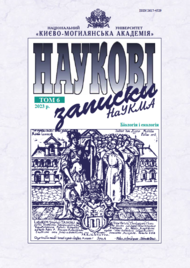Особливості сезонного розвитку видів родів Sedum L. та Hylotelephium H. Ohba в умовах Криворіжжя
DOI:
https://doi.org/10.18523/2617-4529.2023.6.60-67Ключові слова:
фенологія, рід Sedum, рід Hylotelephium, Криворіжжя, кліматичні зміниАнотація
Наведено результати дослідження сезонного розвитку видів родів Sedum L. та Hylotelephium H. Ohba в умовах Криворіжжя протягом 2003–2021 рр. У степовій зоні України глобальні кліматичні зміни пов’язані з підвищенням температур і тривалими посухами, особливо в період активної вегетації рослин, що призводить до стресових умов для їхньої життєдіяльності. Через це рослини, яких використовують в озелененні міських територій, змінюють ритми росту й розвитку, а лімітуючими чинниками стають переважно температура повітря та добовий фотоперіод. Мета роботи – визначити особливості фенології окремих видів родів Sedum L. та Hylotelephium H. Ohba за інтродукції в Криворізький ботанічний сад НАН України за впливу кліматичних змін. Об’єктами дослідження були Sedum aizoon L., S. album L., S. florіferum Praeg., S. hybridum L., S. reflexum L., S. spurium M. Bieb., S. takesimense Nakai, Hylotelephium ewersii (Ledeb.) H. Ohba, H. spectabile (Boreau) H. Ohba. Підвищення річної температури повітря спричинювало зміни термінів і тривалості окремих фаз розвитку вегетативної і генеративної сфер. Зокрема, у 2017–2021 рр. рослини починали розвиток на 8–13 діб раніше (початок березня), а завершували вегетацію значно пізніше (кінець листопада – початок грудня), ніж 19 років тому. Відповідно, вегетаційний період збільшився на 20–50 діб. За інтродукції в Криворізький ботанічний сад НАН України S. florіferum, S. takesimense, S. spurium змінюють феноритмотип із зимово-зеленого на весняно-літньо-осінньо-зелений. З’ясовано, що S. album, S. reflexum, S. spurium, S. florіferum, S. hybridum і S. takesimense, які в природних ареалах цвітуть у липні, в умовах Криворіжжя починають квітування в червні, а у 2017–2021 рр. терміни пришвидшуються – це вже кінець травня – початок червня. Різниця в термінах досягала 12–18 діб. Середня тривалість цвітіння седумів становила 22–30 діб. Протягом 2003–2021 рр. період цвітіння достовірно збільшився у S. aizoon, S. florіferum та S. reflexum. В умовах Криворіжжя види S. florіferum, S. takesimense і S. spurium змінюють стратегію розвитку: не вегетують у зимовий період і цвітуть у червні, що не є характерним для них у природних ареалах. Також відбувається зміна термінів цвітіння на ранньо-літній період у S. album, S. reflexum і S. hybridum, які є літньо-квітучими. Визначені особливості сезонного ритму розвитку вказують на значний рівень пластичності досліджуваних видів.
Посилання
- Chypyliak TF, Leshchenyuk YeN, Linkevich YeA. Seasonal Decoration of Flower Compositions in the Right-Bank Steppe Dnieper Region Under the Influence of Climatic Changes. Darnios Aplinkos Vystymas [Sustainable Environmental Development] [Internet]. 2020;1(17):68–75. Available from: http://ojs.kvk.lt/index.php/DAV/article/view/147/107. Russian.
- Kordyum YeL, Sytnik KM, Baranenko VV, Belyavskaya NA, Klimchuk DA, Nedukha YeM. Cellular mechanisms of plant adaptation to adverse effects of environmental factors in natural conditions. Kyiv: Naukova Dumka; 2003. 279 p. Russian.
- Anjum S, Xie X-y, Wang L-c, Saleem M, Man C, Lei W. Morphological, physiological and biochemical responses of plants to drought stress. African Journal of Agricultural Research. 2011;6(9):2026–32. DOI: 10.5897/AJAR10.027
- Nedukha OM. Plant cell wall and environment. Kyiv: Alterpress; 2015. 291 p. Ukrainian.
- Grodzinskiy DM. Adaptive strategy of plant physiological processes. Kyiv: Naukova Dumka; 2013. 302 p. Russian.
- Buidin Yu. The main tendencies in modern introduction of leading ornamental herbaceous plants in Ukraine. In: Proceedings of the VII International scientific conference. Floriculture: history, theory, practice; 2016 May 24-26; Minsk. Minsk, Belarus; 2016. p. 16–8. Russian.
- Chypyliak TF, Zubrovska OM, Shol HN. Plants in the urbotechnogenic environment of the steppe zone of Ukraine. Kyiv: Talkom; 2022. 390 р. Ukrainian.
- Chuine I. Why does phenology drive species distribution? Phil. Trans. R. Soc. B. 2010;365:3149–60. DOI: 10.1098/rstb.2010.0142
- Bramwell D. Plant adaption and climate change. In: Programme Book of abstract. 2nd World Scientific Congress Challenges in Botanical Research and Climate Change; 2008 29 June – 4 July; Netherlands. Netherlands: Delft; 2008. p. 3.
- Stephenson R. Stonecrops of the Maltese Island group. Sedum Society Newsletter. 2014;111:4–7.
- Pushka IM, Velychko YuA, Osipov MYu, Kozachenko IV. Ecological and biological features of introduced species of the genus Sedum L. in the conditions of the Right-Bank Forest-Steppe of Ukraine. Tauride Scientific Bulletin. Agricultural Sciences. 2019;109(1):212–8. DOI: 10.32851/2226-0099.2019.109-1.31. Ukrainian.
- Paranko IS, Shypunova VO. Climate of Kryvyi Rih. In: Paranko IS, Kazakov VL, Kalinichenko OO, Kotsyuruba VV, Ostapchuk IO, Savosko VM, Shypunova VO, Yarkov SV. Physical geography of Kryvyi Rih. Kryvyi Rih: Ed. RA Kozlov; 2015. p. 82–102. Ukrainian.
- Methods of phenological observations in the botanical gardens of the USSR. Moscow: MBG AS of the USSR; 1975. 27 p. Russian.
- Borisova IV. Seasonal dynamics of the plant community. In: Field geobotany. Vol. 4. Leningrad: Nauka; 1972. p. 5–94. Russian.
- Raunkiaer C. The life forms of plants and statistical plant geography. Oxford: Claredon Press; 1934. 632 p.
- Weather archive: Kryvyi Rih airport [Internet]. 2023 [cited 2023 Mar 27]. Available from: https://meteopost.com/weather/archive/ Ukrainian.
- Mezhenskyj VM. Сlimate changes and their influence on arboreous plants in the south-east of Ukraine. Industrial Botany. 2009;9:56–9. Ukrainian.
- Boychenko S. Modern global climate changes and their manifestations on the territory of Ukraine. Worldview. 2008;1:15–25. Ukrainian.
- Kazakov VL, Paranko IS, Smetana MH, Shypunova VO, Kotsyuruba VV, Kalinichenko OO. The natural geography of Kryvbas. Kryvyi Rih: KDPU; 2005. 156 p. Ukrainian.
- Didukh Yа. Ecological aspects of the global climate changes: reasons, consequences and actions. Bulletin of the NAS of Ukraine. 2009;2:34–44. Ukrainian.
- Laptev AA. Introduction and acclimatization of plants with the basics of landscaping. Kyiv: Phytosociocenter; 2001. 128 p. Russian.
- Zaytsev GN. Mathematical statistics in experimental botany. Moscow: Nauka; 1984. 424 p. Russian.
- Bahuguna RN, Jagadish KS. Temperature regulation of plant phenological development. Environmental and Experimental Botany. 2015;111:83–90.
- Pezzi G, Buldrini F, Mandolfo A, Puppi G, Velli A, Conte L. Phenological and genetic characterization of Sedum hispanicum (Crassulaceae) in the Italian peninsula at the western margin of its distribution. Plant Ecology and Evolution. 2017;150(3): 293–303. DOI: 10.5091/plecevo.2017.1309
- Chuine I, Beaubien E. Phenology is a major determinant of temperate tree range. Ecol. Lett. 2001;4:500–510. DOI: 10.1046/j.1461-0248.2001.00261.x
- Badeck FW, Bondeau A, Bottcher K, Doktor D, Lucht W, Schaber J, Sitch S. Responses of spring phenology to climate change. New Phytol. 2004;162:295–309. DOI: 10.1111/j.1469-8137.2004.01059.x
- Morin X, Thuiller W. Comparing niche- and process-based models to reduce prediction uncertainty in species range shifts under climate change. Ecology. 2009;90:1301–13. DOI: 10.1890/08-0134.1
- Dyachenko AD, Klimenko AV. Perspective plant assortment for using on the roofs of underground facilities. Scientific Bulletin NFTU of Ukraine. 2013;23(5):219–25. Russian.
- Genera of Crassulaceae subfam. Sedoideae. United States Department of Agriculture. Germplasm Resources Information Network (GRIN) [Internet]. 2022 [updated 2022 May 7; cited 2022 Nov 17]. Available from: https://www.ars-grin.gov/cgi-bin/npgs/html/gnlist.pl?1764
- Lee KB, Yoo YG, Park K-R. Morphological Relationships of Korean species of Sedum L. subgenus аizoon (Crassulaceae). Korean Journal of Plant Taxonomy. 2003;33(1):1–15. DOI: 10.11110/kjpt.2003.33.1.001
- Yang C, Wang X, Qin Y, Sun X, Wang Q, Lin H, Xi D. Morphological and Physiological Changes in Sedum spectabile during Flower Formation Induced by Photoperiod. Notulae Botanicae Horti Agrobotanici Cluj-Napoca. 2015;43(2):426–31. DOI: 10.15835/nbha4329824
- Perez G, Chocarro C, Juárez-Escario A, Coma J. Evaluation of the development of five Sedum species on extensive green roofs in a continental Mediterranean climate. Urban Forestry & Urban Greening. 2020;48.126566. DOI: 10.1016/j.ufug.2019.126566
- Lunina NM. Ornamental perennials (assortment, agrotechnics, using). Minsk: Ed. ES Galperin; 1997. 168 p. Russian.
##submission.downloads##
Опубліковано
Як цитувати
Номер
Розділ
Ліцензія
Авторське право (c) 2023 Зубровська О. М., Чипиляк Т. Ф.

Ця робота ліцензується відповідно до Creative Commons Attribution 4.0 International License.
Автори, які публікуються у цьому журналі, погоджуються з такими умовами:
а) Автори зберігають за собою авторські права на твір на умовах ліцензії CC BY 4.0 Creative Commons Attribution International License, котра дозволяє іншим особам вільно поширювати (копіювати і розповсюджувати матеріал у будь-якому вигляді чи форматі) та змінювати (міксувати, трансформувати, і брати матеріал за основу для будь-яких цілей, навіть комерційних) опублікований твір на умовах зазначення авторства.
б) Журнал дозволяє автору (авторам) зберігати авторські права без обмежень.
в) Автори мають право укладати самостійні додаткові угоди щодо поширення твору (наприклад, розміщувати роботу в електронному репозитарії), за умови збереження посилання на його першу публікацію. (Див. Політика Самоархівування)
г) Політика журналу дозволяє розміщення авторами в мережі Інтернет (наприклад, у репозитаріях) тексту статті, як до подання його до редакції, так і під час його редакційного опрацювання, оскільки це сприяє виникненню продуктивної наукової дискусії та позитивно позначається на оперативності та динаміці цитування опублікованої роботи (див. The Effect of Open Access).



